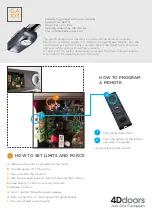
CLOSE SAFETY
OPEN SAFETY
CL OP
FSW
TX
TX
RX
RX
CLOSE SAFETY
CL OP
FSW
RX
TX
Connection of One Pair of Monitored Opening
Photocells and One Pair of Monitored Closing
Photocells
Fig. A6
RX= Receiver Photocell
TX= Transmitter Ptotocell
3. SAFETY DEVICE CONNECTIONS
Fig. A7
Entrapment protection
To comply with the UL325 standard for gate operators every
entrapment zone, as defined in ASTMF2200, must be pro-
tected by two independent entrapment protection devices.
One of the devices is inherent in the E024U control boards
design, the other can be external, like a photocell or an
edge sensor.
See this picture for the photocells positioning:
Fig. A3
Closing Safety Devices
Opening Safety
Devices
Opening Safety Devices:
Are active only during the gate opening movement, and
are suitable for protecting the area between the opening
leaves and fixed obstacles (walls, etc) against the risk of
entrapment
Closing Safety Devices:
Are active only during the gate closing movement, and are
suitable for protecting the closing area against the risk of
entrapment.
Monitored Devices:
Additionaly the UL325 standard requires that every external
entrapment protection device must be monitored for
presence and correct operation. To comply with this
requirement the FAILSAFE function must be activated. This
function tests the photocells before each movement of the
operator. In case the test fails the movement is inhibited.
To activate this function set the dip-switch 12 of DS1 ON,
and connect the negative of the transmitter to the OUT pin
(No.9)
.
See Fig. A6, A7, A8, A10 for wiring examples.
DS1
For UL325 compliance activate
FAILSAFE mode setting dip switch
12 to ON
Connection of One Pair of Monitored Closing Photocells
RX= Receiver Photocell
TX= Transmitter Ptotocell
16” or less
A4















































